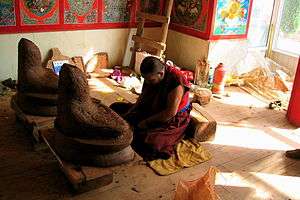Regong arts
The Regong arts (or Rebgong arts)[1] are the popular arts on the subject of Tibetan Buddhism. They are painting, sculpture, engraving, architecture, and embroidery.[2] They are associated with communities in Tongren County and along the river Rongwo which crosses the current Huangnan Tibetan Autonomous Prefecture in the province of Qinghai in China.
| Regong arts | |
|---|---|
The Thangka | |
| Country | China |
| Reference | 00 |
| Region | Asia and Pacific |
| Inscription history | |
| Inscription | 2009 |
| List | Representative |
Regong arts were included in 2009 on the representative list of intangible cultural heritage.[3]
Different Regong arts
- The thangka, also called "tangka", "thanka", or "tanka" (pronunciation : [tʰɑːŋkɑː), literally something which is unrolled, is a painting on canvas characteristic of Tibetan culture. Canvases of all sizes can be found, from thangka portraits which can be unrolled due to two sticks passing through eyelets, up to momentous designed to be unrolled to cover a wall or door, which can measure dozens of metres. The thangkas generally represent mystic symbols (mandala), divinities of Tibetan Buddhism or Bon, or portraits of the Dalai Lama. They are often used as support for meditation.
- The Dui tapestries (duixiu) or barbola are pictures of animals and plants, decorated on silk, which creates a relief. These can be used to decorate columns or on walls.
- Regong sculptures can be made of clay, wood, stone or brick, and decorate temples and homes; mural panels, furniture, or tables for serving tea.
Notes and references
- "The Rise of the Individual through Tibetan Thangka Art in Rebgong". Yale Himalaya Initiative. Retrieved 1 June 2018.
- La Chine au présent : Une fleur de l’art tibétain – Visite au lieu de naissance de l’art Regong
- UNESCO : Les arts Regong : Inscrit en 2009 sur la Liste représentative du patrimoine culturel immatériel de l’humanité
- Les arts tibétains Regong
See also
Linked articles
This article is issued from Wikipedia. The text is licensed under Creative Commons - Attribution - Sharealike. Additional terms may apply for the media files.
